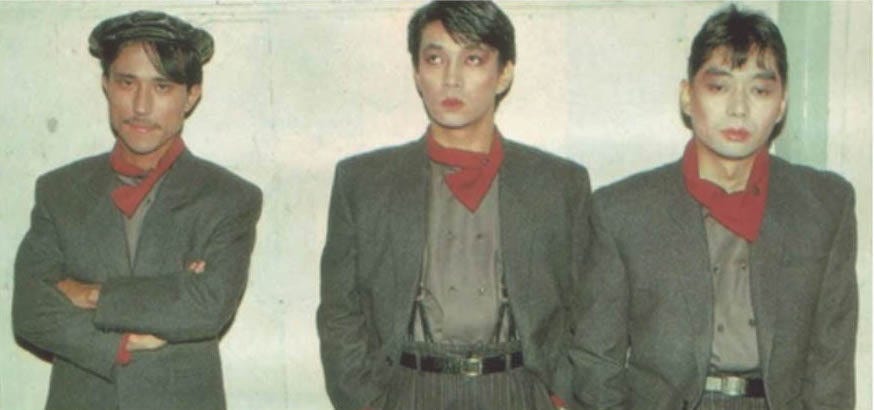Solid A Minus Playlists, Volume 5: Wild Ambitions - The Best of the YMO Boys (1978-1984)
[May, 2023]
In the late seventies, when Yellow Magic Orchestra formed in Tokyo as a kind of avant-garde supergroup—comprising of accomplished solo artists Harry Hosono (synth, vocals) (also of Happy End fame) and Ryuichi Sakamoto (synth, vocals) and Sadistic Mika Band’s Yukihiro Takahashi (drums, lead vocals)—they quickly became hugely popular in their home country. Perhaps at the heart of their success was the winning blend of their personalities, and how these personalities complemented each other in the process of creating music. There was Sakamoto, with his broody intellectual air and classical pianist whizkid background, who brought a sense of theory and form to proceedings, as well as a kind of subdued sensitivity. There was Hosono, obsessed as a child with American country and folk music, and in the early seventies making the natural conversion to hippiedom. After visiting Los Angeles to record an album, he became disenchanted with Americana, and turned his attention towards musical cultures from the Caribbean and Pacific islands. He brought style and feel to the band, and a sense of humour. And finally, in contrast with Sakamoto and Hosono—who were both shy, awkward and sort of unhealthy-looking—there was Takahashi, more approachable, with a hearty twinkle in his eyes and often wearing an interesting hat. He brought them charisma, relatability, and—with his punkish attitude—necessary grit.
Their aim as a supergroup was an ambitious one. Take the danceability of Japan’s own city pop genre and transform it with Japanese technology, as well as the emerging synth music produced at home (Iseo Tomita) and abroad (Kraftwerk, Giorgio Moroder) into a new kind of pop music. At home, their project was a successful one. Very successful. Their second album (Solid State Survivor [Alfa, 1979]) went to number one in Japan’s charts for 82 weeks, and there were the usual antics with fans chasing the YMO boys down alleys and tearing their clothes to shreds. But touring overseas, they encountered an altogether confused audience. Nobody danced. As Hosono recounts, “In Italy, the audience would start arguing during our concert. You had these very serious-looking men with beards and long hair, having a symposium about our music while we were playing.”
If I had been there at the bearded symposium, I’m sorry to say that I’d have sided with the sceptics among those present. I find the first three YMO albums (Yellow Magic Orchestra [Alfa, 1978] Solid State Survivor [Alfa, 1979] and ×∞Multiplies [Alfa, 1980]) to be made up of esoteric songs that are impossible to sink my teeth into. I have difficulty accessing whatever it is about these albums that made them so sensationally received in Japan. For me, the band were all the better for shifting their creative inspiration from krautrock and computer game themes to the cracked glam stylings of Bowie and Roxy Music which culminated during their early- to mid-eighties period. But crucially, they retained the experimentalism of frontiersmen into their poppier years, giving their otherwise slick and smoothly operated synth arrangements a feeling of rawness and unpredictability. There was a grimy and, paradoxical though it may sound, erratically mechanised feel to them that provides a welcome alternative to the sterility of the classic eighties synth sound.
The songs included in this compilation mostly come from this fertile poppier era—roughly spanning the years 1981 to 1984—and include tracks from each band member’s solo work over the same period. I consider this post-Solid State Survivor period to be their absolute best; a time during which the YMO boys surrendered a focus on making new music in favour of a less serious and more sincere sound. Critical to the appeal of their poppier period was a shift in the focus of their humour towards awkward self-deprecation, and in this regard they’re reminiscent of what could be considered their sister band in the West: Talking Heads. They relaxed their futuristic aspirations enough to become more human, more relatable, more fun. Take Hosono’s brilliant “Sports Men”, where he laments his own physical limitations (“People say I’m weak / Can’t even hold her tight”), comparing himself with a combination of awe and aversion with the athletic family of a poolside love interest (“Your brother, they call him Batman / Your sister, we know she’s Wonder Woman”). Rather than exaggerating their awkward elements—as in their earlier years through eccentric costumes and volatile synth soundscapes—they had decided to embrace their awkwardness in a way that was both amusing and entirely relatable.
The slowly-gained recognition of YMO by the West reached a kind of zenith last year. The best songs from Harry’s House [Columbia, 2022]—namely “Music for a Sushi Restaurant”, “Late Night Talking” and “As It Was”—established Harry Styles as a superstar in full bloom. It came as a surprise to me to learn that the title of Harry’s House pays homage to Harry Hosono’s comparatively obscure country-rock-meets-city-pop masterwork Hosono House [Bellwood, 1973]. Musically speaking, there are few similarities between the two albums; there’s nothing particularly country about Harry Styles’ pop formations. Rather, his synthesiser settings sound like they’ve taken their inspiration from YMO at their peak, and the hits sound more like 21st-century interpretations of eighties Japanese synth pop. Perhaps Naughty Harry, in homage to YMO’s Naughty Boys [Alfa, 1983] would have been a more fitting title. In any case, fifty years on the West has finally caught the YMO bug, and last year, one of the most commercially and critically successful artists owed his success in no small part to the YMO sound.
And so, in celebration of the West’s belated appreciation of the trio, and in commemoration of the sad passing of Ryuichi Sakamoto earlier this year, I give you Wild Ambitions: The Best of the YMO Boys (1978-1984).


